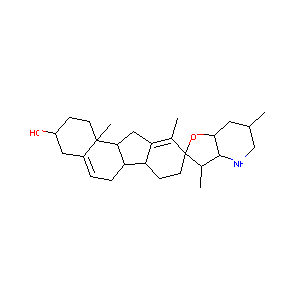Details of the Drug
General Information of Drug (ID: DMEM2SW)
| Drug Name |
CYCLOPAMINE
|
||||||||||||||||||||||
|---|---|---|---|---|---|---|---|---|---|---|---|---|---|---|---|---|---|---|---|---|---|---|---|
| Synonyms |
CYCLOPAMINE; 11-Deoxojervine; 4449-51-8; UNII-ZH658AJ192; CHEMBL254129; CHEBI:4021; 11-Deoxyjervine; ZH658AJ192; HSDB 3505; Jervine, 11-deoxo-; Spiro[9H-benzo[a]fluorene-9,2'(3'H)-furo[3,2-b]pyridin]-3-ol, 1,2,3,3'a,4,4',5',6,6',6a,6b,7,7',7'a,8,11,11a,11b-octadecahydro-3',6',10,11b-tetramethyl-, (2'R,3S,3'R,3'aS,6'S,6aS,6bS,7'aR,11aS,11bR)- (9CI); (3beta,22S,23R)-17,23-epoxyveratraman-3-ol; Veratraman-3-ol, 17,23-epoxy-, (3beta,23beta)-; CY8; [3H]-Cyclopamine; AC1L9DRQ; DSSTox_CID_23709; DSSTox_RID_80067; SCHEMBL29153
|
||||||||||||||||||||||
| Indication |
|
||||||||||||||||||||||
| Drug Type |
Small molecular drug
|
||||||||||||||||||||||
| Structure |
 |
||||||||||||||||||||||
| 3D MOL | 2D MOL | ||||||||||||||||||||||
| #Ro5 Violations (Lipinski): 0 | Molecular Weight (mw) | 411.6 | |||||||||||||||||||||
| Logarithm of the Partition Coefficient (xlogp) | 3.5 | ||||||||||||||||||||||
| Rotatable Bond Count (rotbonds) | 0 | ||||||||||||||||||||||
| Hydrogen Bond Donor Count (hbonddonor) | 2 | ||||||||||||||||||||||
| Hydrogen Bond Acceptor Count (hbondacc) | 3 | ||||||||||||||||||||||
| Chemical Identifiers |
|
||||||||||||||||||||||
| Cross-matching ID | |||||||||||||||||||||||
| Combinatorial Drugs (CBD) | Click to Jump to the Detailed CBD Information of This Drug | ||||||||||||||||||||||
Molecular Interaction Atlas of This Drug
 Drug Therapeutic Target (DTT) |
|
|||||||||||||||||||||||||||||||||||||||||||||||||||||||||||||||||||||||
|---|---|---|---|---|---|---|---|---|---|---|---|---|---|---|---|---|---|---|---|---|---|---|---|---|---|---|---|---|---|---|---|---|---|---|---|---|---|---|---|---|---|---|---|---|---|---|---|---|---|---|---|---|---|---|---|---|---|---|---|---|---|---|---|---|---|---|---|---|---|---|---|---|
 Drug Off-Target (DOT) |
|
|||||||||||||||||||||||||||||||||||||||||||||||||||||||||||||||||||||||
| Molecular Interaction Atlas (MIA) | ||||||||||||||||||||||||||||||||||||||||||||||||||||||||||||||||||||||||
Molecular Expression Atlas of This Drug
| The Studied Disease | Discovery agent | |||||||||||||||||||||||
|---|---|---|---|---|---|---|---|---|---|---|---|---|---|---|---|---|---|---|---|---|---|---|---|---|
| ICD Disease Classification | N.A. | |||||||||||||||||||||||
|
||||||||||||||||||||||||
| Molecular Expression Atlas (MEA) | ||||||||||||||||||||||||
References
